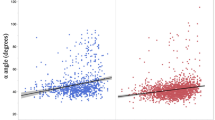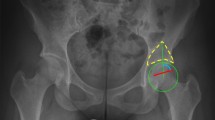Abstract
Femoroacetabular impingement (FAI) is characterized by abnormal contact between the proximal femur and the acetabulum. Two subtypes have been described: pincer impingement, caused by an overcovered acetabulum; and cam impingement, which occurs as a result of an aspherical femoral head (cam abnormality). A strong correlation exists between cam impingement and the subsequent development of hip osteoarthritis (OA). Major cam abnormalities confer a high risk of OA. However, the association between cam abnormalities and the pathology of OA has been difficult to compare between studies, as different methods have been used to define the abnormality. Cam abnormalities are acquired during skeletal growth and could be influenced by high impact sporting activities. Preventative treatments aiming to reduce the incidence of cam abnormalities and subsequent OA could, therefore, be developed. In this Perspective, we discuss the current understanding of FAI, focusing on cam abnormalities and their association with OA.
This is a preview of subscription content, access via your institution
Access options
Subscribe to this journal
Receive 12 print issues and online access
$209.00 per year
only $17.42 per issue
Buy this article
- Purchase on Springer Link
- Instant access to full article PDF
Prices may be subject to local taxes which are calculated during checkout


Similar content being viewed by others
References
Smith-Petersen, M. N. Treatment of malum coxae senilis, old slipped upper femoral epiphysis, intrapelvic protrusion of the acetabulum, and coxa plana by means of acetabuloplasty. J. Bone Joint Surg. Am. 18, 869–880 (1936).
Murray, R. O. The aetiology of primary osteoarthritis of the hip. Br. J. Radiol. 38, 810–824 (1965).
Solomon, L. Patterns of osteoarthritis of the hip. J. Bone Joint Surg. Br. 58, 176–183 (1976).
Ganz, R. et al. Femoroacetabular impingement: a cause for osteoarthritis of the hip. Clin. Orthop. Relat. Res. 417, 112–120 (2003).
Beck, M., Kalhor, M., Leunig, M. & Ganz, R. Hip morphology influences the pattern of damage to the acetabular cartilage: femoroacetabular impingement as a cause of early osteoarthritis of the hip. J. Bone Joint Surg. Br. 87, 1012–1018 (2005).
Hack, K., Di Primio, G., Rakhra, K. & Beaule, P. E. Prevalence of cam-type femoroacetabular impingement morphology in asymptomatic volunteers. J. Bone Joint Surg. Am. 92, 2436–2444 (2010).
Gosvig, K. K., Jacobsen, S., Sonne-Holm, S., Palm, H. & Troelsen, A. Prevalence of malformations of the hip joint and their relationship to sex, groin pain, and risk of osteoarthritis: a population-based survey. J. Bone Joint Surg. Am. 92, 1162–1169 (2010).
Agricola, R. et al. The development of Cam-type deformity in adolescent and young male soccer players. Am. J. Sports Med. 40, 1099–1106 (2012).
Siebenrock, K. A. et al. The cam-type deformity of the proximal femur arises in childhood in response to vigorous sporting activity. Clin. Orthop. Relat. Res. 469, 3229–3240 (2011).
Gosvig, K. K., Jacobsen, S., Palm, H., Sonne-Holm, S. & Magnusson, E. A new radiological index for assessing asphericity of the femoral head in cam impingement. J. Bone Joint Surg. Br. 89, 1309–1316 (2007).
Notzli, H. P. et al. The contour of the femoral head-neck junction as a predictor for the risk of anterior impingement. J. Bone Joint Surg. Br. 84, 556–560 (2002).
Nicholls, A. S. et al. The association between hip morphology parameters and nineteen-year risk of end-stage osteoarthritis of the hip: a nested case–control study. Arthritis Rheum. 63, 3392–3400 (2011).
Agricola, R. et al. Cam impingement causes osteoarthritis of the hip: a nationwide prospective cohort study (CHECK). Ann. Rheum. Dis. 72, 918–923 (2013).
Allen, D., Beaule, P. E., Ramadan, O. & Doucette, S. Prevalence of associated deformities and hip pain in patients with cam-type femoroacetabular impingement. J. Bone Joint Surg. Br. 91, 589–594 (2009).
Doherty, M. et al. Nonspherical femoral head shape (pistol grip deformity), neck shaft angle, and risk of hip osteoarthritis: a case–control study. Arthritis Rheum. 58, 3172–3182 (2008).
Bardakos, N. V. & Villar, R. N. Predictors of progression of osteoarthritis in femoroacetabular impingement: a radiological study with a minimum of ten years follow-up. J. Bone Joint Surg. Br. 91, 162–169 (2009).
Pollard, T. C. et al. Localized cartilage assessment with three-dimensional dGEMRIC in asymptomatic hips with normal morphology and cam deformity. J. Bone Joint Surg. Am. 92, 2557–2569 (2010).
Ito, K., Minka, M. A., Leunig, M., Werlen, S. & Ganz, R. Femoroacetabular impingement and the cam-effect. A MRI-based quantitative anatomical study of the femoral head-neck offset. J. Bone Joint Surg. Br. 83, 171–176 (2001).
Anderson, L. A. et al. Acetabular cartilage delamination in femoroacetabular impingement. Risk factors and magnetic resonance imaging diagnosis. J. Bone Joint Surg. Am. 91, 305–313 (2009).
Reichenbach, S. et al. Association between cam-type deformities and magnetic resonance imaging-detected structural hip damage: a cross-sectional study in young men. Arthritis Rheum. 63, 4023–4030 (2011).
Murray, R. O. & Duncan, C. Athletic activity in adolescence as an etiological factor in degenerative hip disease. J. Bone Joint Surg. Br. 53, 406–419 (1971).
Siebenrock, K. A. et al. Abnormal extension of the femoral head epiphysis as a cause of cam impingement. Clin. Orthop. Relat. Res. 418, 54–60 (2004).
Dudda, M. et al. Morphologic differences between the hips of Chinese women and white women: could they account for the ethnic difference in the prevalence of hip osteoarthritis? Arthritis Rheum. 63, 2992–2999 (2011).
Pollard, T. C. et al. Genetic influences in the aetiology of femoroacetabular impingement: a sibling study. J. Bone Joint Surg. Br. 92, 209–216 (2010).
Gerhardt, M. B. et al. The prevalence of radiographic hip abnormalities in elite soccer players. Am. J. Sports Med. 40, 584–588 (2012).
Siebenrock, K. A., Behning, A., Mamisch, T. C. & Schwab, J. M. Growth plate alteration precedes cam-type deformity in elite basketball players. Clin. Orthop. Relat. Res. 471, 1084–1091 (2013).
Clohisy, J. C. et al. Clinical presentation of patients with symptomatic anterior hip impingement. Clin. Orthop. Relat. Res. 467, 638–644 (2009).
Rakhra, K. S., Lattanzio, P. J., Cardenas-Blanco, A., Cameron, I. G. & Beaule, P. E. Can T1-rho MRI detect acetabular cartilage degeneration in femoroacetabular impingement?: a pilot study. J. Bone Joint Surg. Br. 94, 1187–1192 (2012).
Krekel, P. R., Vochteloo, A. J., Bloem, R. M. & Nelissen, R. G. Femoroacetabular impingement and its implications on range of motion: a case report. J. Med. Case Rep. 5, 143 (2011).
Tannast, M. et al. Noninvasive three-dimensional assessment of femoroacetabular impingement. J. Orthop. Res. 25, 122–131 (2007).
Author information
Authors and Affiliations
Contributions
R. Agricola, G. E. Thomas and S. Glyn-Jones researched data for the article. R. Agricola, G. E. Thomas, S. Glyn-Jones, J. H. Waarsing, N. K. Arden, S. M. A. Bierma-Zeinstra and H. Weinans made substantial contributions to discussing content and writing the article. All authors reviewed and edited the manuscript.
Ethics declarations
Competing interests
The authors declare no competing financial interests.
Supplementary information
Supplementary Table 1
Studies examining α angle (DOC 69 kb)
Rights and permissions
About this article
Cite this article
Agricola, R., Waarsing, J., Arden, N. et al. Cam impingement of the hip—a risk factor for hip osteoarthritis. Nat Rev Rheumatol 9, 630–634 (2013). https://doi.org/10.1038/nrrheum.2013.114
Published:
Issue Date:
DOI: https://doi.org/10.1038/nrrheum.2013.114
This article is cited by
-
Factors associated with cam deformity in Japanese local residents
Scientific Reports (2024)
-
Präoperative MRT-Bildgebung bei Hüftdysplasie
Die Orthopädie (2023)
-
Non-operative Management and Outcomes of Femoroacetabular Impingement Syndrome
Current Reviews in Musculoskeletal Medicine (2023)
-
Hip Labral Morphological Changes in Patients with Femoroacetabular Impingement Speed Up the Onset of Early Osteoarthritis
Calcified Tissue International (2023)
-
Global, regional, and national burdens of hip osteoarthritis from 1990 to 2019: estimates from the 2019 Global Burden of Disease Study
Arthritis Research & Therapy (2022)



